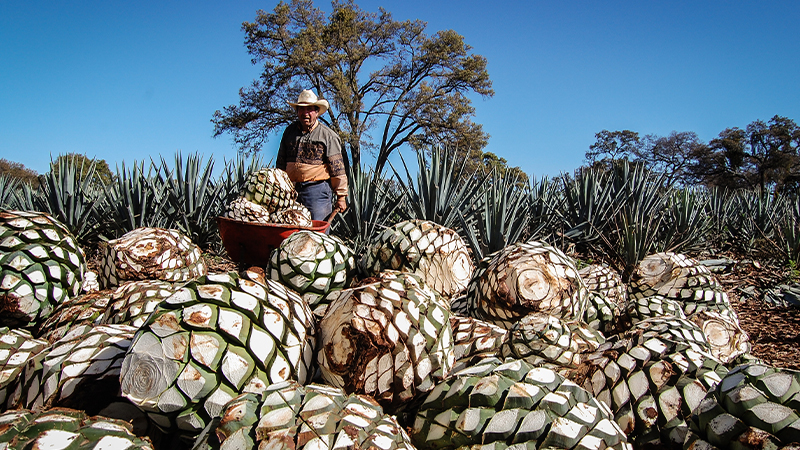
Long before launching Tequila Ocho, Carlos Camarena knew that his tequilas expressed a unique sense of place. The Camarena family has produced tequila since 1937, harvesting from their agave fields scattered across the highlands of Jalisco. Carlos Camarena — the third generation of his family to produce tequila from these estates — had experienced first-hand the varying aromas and flavors that agave harvested from different fields imparted on the spirit. He recognized the subtle impacts that different soils, microclimates, elevations, and topographies made on each batch and, rather than neutralize those differences, chose to embrace them.
So, while others debated whether distilled spirits could express terroir — a term typically associated with wine to describe the totality of the environmental factors impacting a specific vintage — for Camarena that was never the critical question. For him and his partner, the renowned tequila evangelist and restaurateur Tomas Estes, the question was simple: How do we create a tequila that celebrates, rather than dilutes, terroir?
The Tequila Ocho Difference
Launched in 2008 by Camarena and Estes, Tequila Ocho was the answer. But to fully appreciate how Tequila Ocho demonstrates the nuances that single-estate agave can provide tequila with, it’s important to understand that tequila producers typically go to great lengths to iron those very nuances from their products.
Distillers and blenders make all kinds of adjustments throughout the production process that help them achieve a uniform flavor profile in their finished products. Doing so allows them to develop a house style and build brand loyalty with consumers, but it doesn’t do much to showcase the influence of terroir, and honestly, nobody had really thought about tequila like that until Carlos and Tomas got together. In achieving consistency, tequila producers often sacrifice the minute impacts of soil and climate on the Blue Weber agave that Tequila Ocho seeks to celebrate.
Creating a single-estate tequila reflective of its terroir requires some significant deviations from conventional tequila production, from the farming and sourcing of the agave straight through to the final maturation and bottling. To allow a unique sense of place to shine in a finished tequila, the spirit can be neither mass produced nor muddied by flavor additives or heavy-handed barrel aging.
It requires small batches of agave grown together in the same place and thoughtful fermentation and distillation processes that preserve the natural agave essence of the spirit. The fact that the Camarena family works exclusively with agave from their own estates provides Tequila Ocho with an agave-to-glass control over the entire tequila-making process, which makes single-estate tequila not only possible but preferable.
The Art of Vintage Tequila
To craft its vintages, Tequila Ocho annually harvests agave from three to four of its nearly 100 estates, each of which is located in a different part of Los Altos de Jalisco. It’s the distinctions between these estates that imbue each single-estate tequila with its unique character. It’s not just differences in elevation, soil content, or microclimate that shape terroir, though each plays a significant role.
The degree to which field slopes can impact everything from the plants’ orientation to the sun to how quickly the soils drain after a rainstorm (which in turn impacts humidity and the local microclimate). Varying proximities to trees or surface water impact the biodiversity within each plot as well, not only in terms of flora and fauna but also in terms of the insects that live within the soil.
All of these factors in concert impact the agaves development at a biochemical level, which could explain why vintage 2015 from the “Loma Alta” estate (at roughly 2,050 meters elevation) exhibits a great deal of grapefruit citrus, orange blossom, and herbal notes while vintage 2020’s “Cerro Grande” agaves offer up notes of mineral, black pepper, and cooked agave (from 250 meters higher).
When an estate is harvested, the agaves undergo a natural, open-vat fermentation allowing native yeasts and bacteria in the air to mix freely with the fermenting agave sugars, creating an additional opportunity for the natural environment to influence the development of flavors and aromas.
Tequila Ocho’s aged expressions are then matured in well-used former American whiskey oak barrels that impart a very restrained wood influence to the spirit so that its agave notes remain focused and precise. By ensuring nothing is added, ever, during the production process, Camarena allows the terroir of Tequila Ocho’s single estates to shine through in the aromas and character of the final product. By taking nothing away, he ensures each vintage is full of the ripe agave character that runs through every bottle of Tequila Ocho.
The result is the only single-estate tequila on the market, one that stands up perfectly well in a cocktail but that’s really designed for sipping, savoring, and contemplating. Each vintage expresses itself differently, making each bottle something of a time capsule — not exactly a limited release (as there will always be another vintage next year), but reflective enough of a certain time and place that it will never be reproduced in exactly the same way again.
This article is sponsored by Tequila Ocho.


